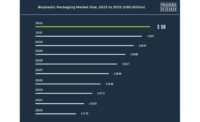Inflationary pressure will continue to rise in 2022, with food packaging being a major contributor, due to high demand, supply disruptions and cost increases.
Heading into 2022, U.S. consumer retail demand remains strong. Total retail sales achieved 10.3% compound annual growth rate in the past two years, with goods requiring more packaging than before. In many cases, the demand exceeded the growth in packaging production, leading to a tight food packaging market with high operating rates1 across various materials, such as beverage cans, corrugated boxes and PET milk bottles. Meanwhile, cost inflation is increasingly hitting the packaging sector due to increases in energy, transportation and labor costs. Along with the ongoing conflict between Russia and Ukraine, these factors will lead to continued price increases of food packaging in the next 12 months.
U.S. corrugated containerboard has seen five price increases as tracked by RISI since the pandemic, one price increase less than in the past decade. Surging e-commerce sales, which jumped 14.3% since 2020, recent cost increases, and a consolidated industry led to ongoing price increases.
While fiber is the most important cost component — which in North America is relatively shielded from the impact of the Russia-Ukraine war — other supply chain factors can add up and swing paper prices as well, such as the following:
- Soaring energy costs in Europe have created massive uncertainties for European paper producers. In Q4 2021, petroleum-based energy accounted for 3% to 8% of the total cash costs in North America (see Figure 3). With a potential 45% increase in crude oil prices, energy costs for paper packaging are expected to increase by 3.4%.
- As a result of the expected double-digit increase in transportation costs and rise in fuel costs, production costs are expected to increase by 2.3% to 3.6%.
- Corn starch is a small yet essential paper-making chemical in North America, where the market has already experienced tight supply and high demand over the past two years. Since the Russia-Ukraine war, corn prices surged again, with prices now twice as high as two years ago, strongly indicating a continued upward trend in corn starch pricing.
Due to the short-term capacity constraints and cost increases, it would not be surprising to see double-digit growth in corrugated prices in 2022. There is, however, ample supply from conversion and greenfield projects expected to come online starting 2023. This will bring some relief to food manufacturers from multi-year inflation, while potentially pressuring margin of corrugated producers.
Folding carton packaging has a more stable demand outlook, but is subject to the same general underlying inflationary factors as corrugated packaging, thus will not be discussed separately.
Plastic Resins
Over the last two years, we have experienced once-in-a-lifetime increases in plastic packaging pricing as a result of weather events, infrastructure breakdown, Covid-19 and labor shortages. Demand for resins remains strong as the U.S. economy has shown resilience, even in the face of higher inflation and fuel prices.
Prices of major packaging resins, such as PET, were up $0.26/lb, or 48.6%, in 2021. Recent events in Ukraine continue the upward pressure on packaging resins, with regional PET prices increasing by $0.20/lb in the first two months of 2022. North America depends heavily on imported material and there has been no improvement on that front with continued supply issues in domestic PET production.
The ongoing war in Ukraine has led to volatility in global energy markets, pressuring upward movement in packaging resins. Polyethylene suppliers announced an increase of $0.04 /lb in March, with further increases of $0.04-USD 0.05/lb in April. Polystyrene used in foodservice packaging is experiencing a $0.05/lb hike due to higher costs for monomers and benzene feedstock. Prices are moving upward all along the resin supply chains.
Despite the price increases, some relief is on the way in North America, particularly in polyethylene supply. Shell Chemicals’ new plant in Western PA is coming online this year, as will Exxon-SABIC in Texas and Nova Chemicals in Canada. Most of these plants were originally destined for the export markets, but logistical problems may hinder the 40% export goal and redirect some supply to relief domestic markets.
Other Packaging Materials
Aluminum has experienced significant price volatility with a price increase of over 40% in the past two years. The U.S. market continues to be dominated by the enormous supply gap that led to 15bn cans being imported in 2021, or more than 15% of long-term demand in the U.S. On top of the already large supply and demand constraints in the global market, the recent energy price surge has added another layer of inflation to the energy-intensive industry. Not only do we expect higher prices in 2022, but we also expect small beverage producers to face continued risk of aluminum can supply shortage.
The glass packaging supply chain is energy-intensive and is expected to be heavily impacted by rising energy costs. As the largest importer of glass bottles, U.S. glass bottle supply is more closely linked to the global market, and the impact of the EU energy crisis may be more pronounced.
Tight supply, especially for wineries, distillers and craft brewers, as well as higher cost are expected for the next twelve months.
High inflationary pressure is expected and up to double-digit price increases for various food packaging materials in 2022. In light of the Russia-Ukraine war, uncertainties and rate volatilities persist. Food producers and retailers may feel the burn on top of already squeezed margins with tough price negotiations happening throughout the supply chain. Consumers will ultimately end up paying for some, if not all of it.
1 The operating rate is the portion of capacity at which a business operates. It is a common indicator of market tightness.



